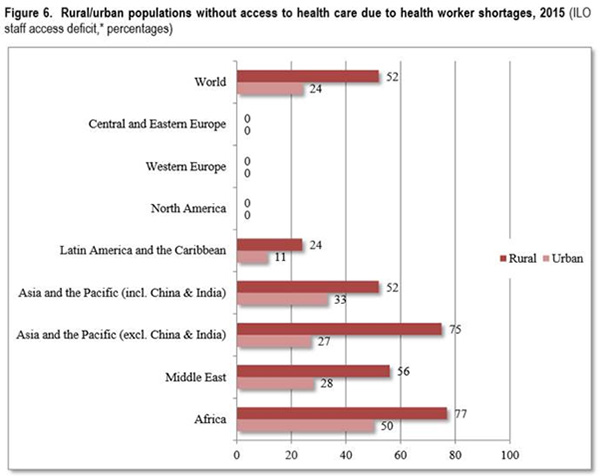
New ILO Report: The World Needs More Rural Health Workers, A Lot More
 On April 27, a new report released by the United Nations International Labour Organization (ILO) made a distressing finding: without adequate numbers of health workers, especially in rural areas, more than half of the world’s rural population—and more than three-quarters of the rural population in Africa—will go without access to effective health care in 2015.
On April 27, a new report released by the United Nations International Labour Organization (ILO) made a distressing finding: without adequate numbers of health workers, especially in rural areas, more than half of the world’s rural population—and more than three-quarters of the rural population in Africa—will go without access to effective health care in 2015.
The report, entitled Global Evidence on Inequities in Rural Health Protection, was the ILO’s response to observable trends in economic disinvestment and neglect in rural health systems around the world. Now, with this report indicating that nearly 56% of the world’s rural population—and 83% of Africa’s rural population—live without critical health care access, the ILO has provided powerful evidence to demonstrate why strengthening the rural health workforce is imperative to filling this gap.
According to the report, inadequate numbers of rural health workers is one of most crippling determinants of poor access to health services in rural areas across the globe. While approximately half of the world’s population resides in rural areas, only 23% of the health workforce is stationed here. This amounts to a deficit of approximately seven million health workers in rural areas, comprising the vast majority of the ILO’s estimated 10.3 million global health worker deficit. [1]
“Health workers are a prerequisite for access to health care. Without skilled health workers, no quality health services can be delivered to those in need,” asserts this report.

So, what do the recorded health workforce shortages mean for people’s access to life-saving health services? ILO research provides a grim response to this question: precisely because of these health workforce deficits, 50% of rural areas and 24% of urban areas lack access to the essential health services they need. In Africa, the impact of health workforce shortages is even more acute: half of urban residents lack access to health care due to health worker shortages, and a staggering 77% of rural residents lack essential health coverage, precisely because they are devoid of the health workers needed to serve their communities.
Even more striking is evidence that shows that these health worker shortages not only impede accessibility to health services, but have a direct and real impact on health outcomes as well. Data collected by the ILO demonstrate that the maternal mortality rate in rural areas is very strongly correlated with the degree of health workforce shortages in that area: “with decreasing levels of health workers, particularly midwives, the maternal mortality rate increases significantly,” warns the report.
In this context, the ILO makes a powerful assertion: national and global health policies must prioritize investments needed to “train, employ, remunerate, and motivate” the rural health workforce we need to bridge inequalities in access to basic health services, and accelerate progress in meeting global health goals. In rural areas especially, improvements must be made in guaranteeing safe and decent working conditions in rural facilities, appropriate wages, and additional incentives to recruit and retain staff.
Improving the infrastructure of rural hospitals and guaranteeing the provision of much-needed equipment, supplies, and transport services for rural health workers can also go a long way in building this rural health workforce. With the international community now coming together to strive for universal health coverage as a major global health priority, we must acknowledge how these critical investments in frontline health workforce strengthening are central to achieving this goal.
[1] The ILO has calculated the 10.3 million global health workforce shortage based on a threshold of 41.1 health workers per 10,000 people.
This post originally appeared on the Frontline Health Workers Coalition blog. Aanjalie Collure is a communications fellow at IntraHealth International.
Help CapacityPlus spread the word about strengthening the health workforce. Follow us on Twitter and like us on Facebook.
Related items:
Author photo courtesy of Aanjalie Collure. Figure from ILO report: Global Evidence on Inequalities in Rural Health Protection (2015)


